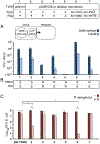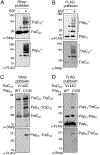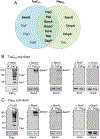Two pKM101-encoded proteins, the pilus-tip protein TraC and Pep, assemble on the Escherichia coli cell surface as adhesins required for efficient conjugative DNA transfer
- PMID: 30264928
- PMCID: PMC6351158
- DOI: 10.1111/mmi.14141
Two pKM101-encoded proteins, the pilus-tip protein TraC and Pep, assemble on the Escherichia coli cell surface as adhesins required for efficient conjugative DNA transfer
Abstract
Mobile genetic elements (MGEs) encode type IV secretion systems (T4SSs) known as conjugation machines for their transmission between bacterial cells. Conjugation machines are composed of an envelope-spanning translocation channel, and those functioning in Gram-negative species additionally elaborate an extracellular pilus to initiate donor-recipient cell contacts. We report that pKM101, a self-transmissible MGE functioning in the Enterobacteriaceae, has evolved a second target cell attachment mechanism. Two pKM101-encoded proteins, the pilus-tip adhesin TraC and a protein termed Pep, are exported to the cell surface where they interact and also form higher order complexes appearing as distinct foci or patches around the cell envelope. Surface-displayed TraC and Pep are required for an efficient conjugative transfer, 'extracellular complementation' potentially involving intercellular protein transfer, and activation of a Pseudomonas aeruginosa type VI secretion system. Both proteins are also required for bacteriophage PRD1 infection. TraC and Pep are exported across the outer membrane by a mechanism potentially involving the β-barrel assembly machinery. The pKM101 T4SS, thus, deploys alternative routing pathways for the delivery of TraC to the pilus tip or both TraC and Pep to the cell surface. We propose that T4SS-encoded, pilus-independent attachment mechanisms maximize the probability of MGE propagation and might be widespread among this translocation superfamily.
© 2018 John Wiley & Sons Ltd.
Figures






Similar articles
-
TraC of IncN plasmid pKM101 associates with membranes and extracellular high-molecular-weight structures in Escherichia coli.J Bacteriol. 1999 Sep;181(18):5563-71. doi: 10.1128/JB.181.18.5563-5571.1999. J Bacteriol. 1999. PMID: 10482495 Free PMC article.
-
Structural bases for F plasmid conjugation and F pilus biogenesis in Escherichia coli.Proc Natl Acad Sci U S A. 2019 Jul 9;116(28):14222-14227. doi: 10.1073/pnas.1904428116. Epub 2019 Jun 25. Proc Natl Acad Sci U S A. 2019. PMID: 31239340 Free PMC article.
-
The TraK accessory factor activates substrate transfer through the pKM101 type IV secretion system independently of its role in relaxosome assembly.Mol Microbiol. 2020 Aug;114(2):214-229. doi: 10.1111/mmi.14507. Epub 2020 Apr 19. Mol Microbiol. 2020. PMID: 32239779 Free PMC article.
-
Molecular basis of conjugation-mediated DNA transfer by gram-negative bacteria.Curr Opin Struct Biol. 2025 Feb;90:102978. doi: 10.1016/j.sbi.2024.102978. Epub 2025 Jan 16. Curr Opin Struct Biol. 2025. PMID: 39823762 Review.
-
Conjugation in Gram-Positive Bacteria.Microbiol Spectr. 2014 Aug;2(4):PLAS-0004-2013. doi: 10.1128/microbiolspec.PLAS-0004-2013. Microbiol Spectr. 2014. PMID: 26104193 Review.
Cited by
-
Ligand-Displaying E. coli Cells and Minicells for Programmable Delivery of Toxic Payloads via Type IV Secretion Systems.bioRxiv [Preprint]. 2023 Aug 12:2023.08.11.553016. doi: 10.1101/2023.08.11.553016. bioRxiv. 2023. Update in: mBio. 2023 Oct 31;14(5):e0214323. doi: 10.1128/mbio.02143-23. PMID: 37609324 Free PMC article. Updated. Preprint.
-
Molecular Mechanisms Influencing Bacterial Conjugation in the Intestinal Microbiota.Front Microbiol. 2021 Jun 4;12:673260. doi: 10.3389/fmicb.2021.673260. eCollection 2021. Front Microbiol. 2021. PMID: 34149661 Free PMC article. Review.
-
Encounter rates and engagement times limit the transmission of conjugative plasmids.PLoS Genet. 2025 Feb 7;21(2):e1011560. doi: 10.1371/journal.pgen.1011560. eCollection 2025 Feb. PLoS Genet. 2025. PMID: 39919124 Free PMC article.
-
Conjugative delivery of toxin genes ccdB and kil confers synergistic killing of bacterial recipients.J Bacteriol. 2025 Jul 24;207(7):e0016825. doi: 10.1128/jb.00168-25. Epub 2025 Jul 3. J Bacteriol. 2025. PMID: 40608358 Free PMC article.
-
Type IV Coupling Proteins as Potential Targets to Control the Dissemination of Antibiotic Resistance.Front Mol Biosci. 2020 Aug 12;7:201. doi: 10.3389/fmolb.2020.00201. eCollection 2020. Front Mol Biosci. 2020. PMID: 32903459 Free PMC article. Review.
References
-
- Aly KA, and Baron C (2007) The VirB5 protein localizes to the T-pilus tips in Agrobacterium tumefaciens. Microbiology 153: 3766–3775. - PubMed
Publication types
MeSH terms
Substances
Grants and funding
LinkOut - more resources
Full Text Sources
Other Literature Sources
Miscellaneous

